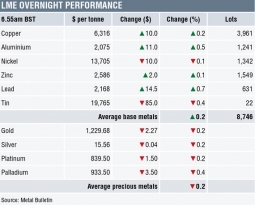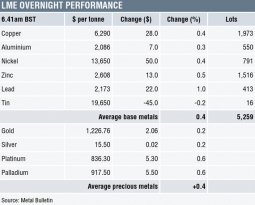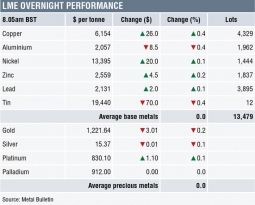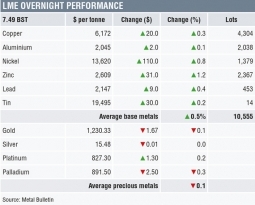The London Metal Exchange (LME) must overcome a general sense of scepticism and an increasingly crowded marketplace when it rolls out its new precious metals contracts next year.
Working with the World Gold Council (WGC) and with support from five banks and one proprietary trading house, the LME will launch London spot, futures and options contracts for gold and silver in the first half of 2017. Platinum and palladium contracts will follow later.
But the market is largely sceptical about the new LME/WGC precious metals venture for now.
“I just don’t have a lot of confidence that the LME can influence the precious metals market,” one market participant said.
The LME has not traded precious metals since the 1990s. Its only foray into gold futures trading dates back to 1982 when it joined gold industry participants to launch the London Gold Futures Market (LGFM). But the lack of speculative investors caused the market to close within three years.
The exchange lost out in the race to administer the London gold fix in November 2014 – it is now in the hands of ICE – although it won the administration of the platinum and palladium price fixes in October 2014.
The LME’s credibility is a concern for some – recent clashes with users over fee increases and falling volumes show it has many issues to contend with.
Another worry for the gold market is the fact that the new suite of precious metals contracts – called LMEprecious – does not have the backing of the London Bullion Market Association (LBMA), which is the leading authority on the London bullion market and the governor of the good delivery list.
“I’m not so optimistic about LME’s gold contracts. The gold market has always been used to using the OTC market to trade,” another industry source said.
The London gold market is primarily over-the-counter (OTC), with trades taking place privately between counterparties rather than on an exchange. But liquidity has dropped over the past year – many banks have pulled out of commodities and exited precious metals due to the advent of tighter regulation following the 2008 financial and banking crisis.
The new set of contracts is a response to that change in regulatory environment, the LME and the WGC have jointly said.
“It is always better to anticipate and be prepared than wait and catch up,” Aram Shishmanian, CEO of the WGC, said.
All trading of the new LME contracts will be centrally cleared on LME Clear, the LME’s clearing house.
“The market has been adamant about not clearing unless it’s mandated to do so, a regulatory change that’s been years in the making and keeps getting pushed back. Without a regulatory requirement the market just won’t budge,” another market participant said.
And market participants would like to see liquidity in these new contracts before trading them, many said.
“Liquidity is the most important thing for us,” one bank official said. “Our traders are only allowed to trade a futures contract if the contract is liquid. They must be able to sell it easily – if not, it would be a risk to us.”
The LME, meanwhile, said it is hoping to attract more players before the new contracts go live. “With most new efforts you need the ‘coalition of the willing’ to get things moving. You can’t get everyone there on day one,” LME CEO Garry Jones said.
Goldman Sachs, ICBC Standard Bank, Morgan Stanley, Natixis, OSTC and Societe Generale will act as the initial liquidity providers but large-volume entities such as HSBC, UBS, JPMorgan and Scotia are not involved, some sources noted.
Also fighting for the control of the London gold market is Intercontinental Exchange, which also won in November 2014 the race to administer the London gold fix. The exchange is set to launch a rival gold futures contract next year.
But with the LBMA separately attempting to set up its own trading platform to improve transparency in the $5 trillion per year London gold market, there are concerns about the risks of overkill.
“A little like sharks in a feeding frenzy, various exchanges and unheard of companies seem to be attempting to kill a market that is alive and well,” David Govett, head of precious metals at Marex Spectron said.
“The LME, ICE and the LBMA themselves are all launching futures contracts, trading platforms and who knows what else in an attempt to break up the centuries-old OTC London gold market,” he added.
In the first quarter of 2017, the LBMA – together with Boat Services and Autilla – will roll out its own trade reporting service. It also has plans to launch further services in the future, such as a trading venue and OTC Clearing/CCP as and when the market requires.
The two start-ups were chosen over larger industry bodies, including the LME, CME and ICE.
“Do we really need multiple industry bodies working towards the same goal but not working with each other?” one banking source asked.
But there are specification differences between the contracts – the LME contract will be focused on London while the CME contracts are New York-oriented, CME head of precious metals Miguel Vias noted.
“It is difficult to do a global gold contract. The Comex contract comes as close as you can get… There will continue to be regional differences [for gold contracts] and we will certainly continue to do what we can to make sure Comex remains the global standard,” he added.
Competition is healthy for the market, ensuring London remains a viable and stable marketplace, Vias said
“London is going through some big changes and you are watching multiple players trying to help the market move forward,” he told Metal Bulletin. “I like the fact there are so many eyes on London making sure it remains a healthy viable liquidity pool.”
(Additional reporting by Vivian Teo, editing by Mark Shaw)
The post LME must tackle rivals, scepticism in race for London’s gold market appeared first on The Bullion Desk.
Read More
Source: Bullion Desk News








